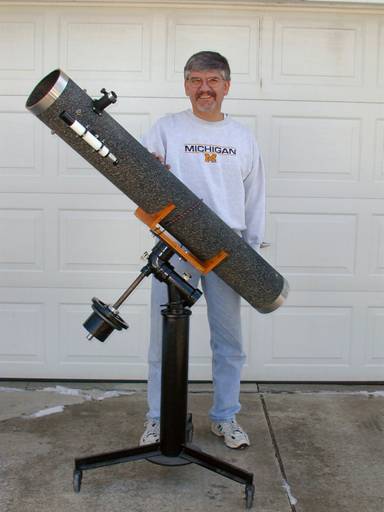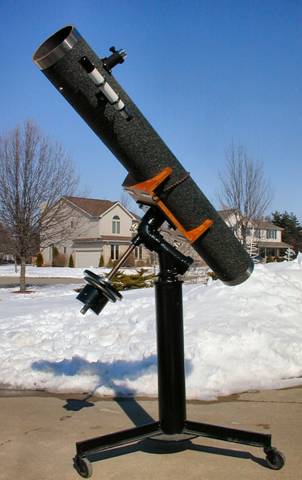


When you think about it, paying someone back for an act of kindness is pretty easy. After all, you’re simply treating someone the way they treated you. But that original act is a little more difficult to do. You have to “pay forward,” not knowing how it will be received or if anything good will come out of it. But I was a direct recipient of just such an act, and that’s how I got started in amateur astronomy.
Growing up in Detroit in 1969, when I was 14 years old, a neighbor (his name was Ed) from across the street came over one day and asked me if I would like a telescope. They were moving and they were trying to clean out their house beforehand. Now being 14 years old, and not being acquainted with “real” telescopes, naturally I’m thinking to myself that he’s talking about one of those cheap little 60mm refractors you see in Sears and KMart and other department stores. So I tell him “Sure, I’ll take it.” He goes back across the street and comes back, wheeling (what I considered at the time) a HUGE, homemade 6-inch f/8 reflector, on a heavy duty machined pipe mount! Then he goes back home again and brings back a big box full of astro-goodies, including eyepieces, a copy of Norton’s Star Atlas, Sky and Telescope magazines, mirror making materials, Edmund Scientific books, and a copy of Allyn Thompson’s how-to book Making Your Own Telescope. I think I just stood there with my mouth agape. Not knowing quite what I was looking at, I start asking questions. That’s when Ed tells me that there’s a catch. The catch is that the scope is almost complete, but there was no primary mirror. “Mirror?” I thought to myself, “I thought telescopes have lenses, not mirrors.” To make a long story short, Ed had spent countless hours building everything, including grinding and polishing the primary mirror. He was in the final figuring stage, and while attempting to star test it uncoated in the telescope to verify the accuracy of the figure, he dropped it and broke it. In an instant, several months worth of precious spare time (he and his wife had three small children who kept them very busy) flushed down the toilet! He just didn’t have the heart or energy to attempt to do it over, so he gave it all to me, hoping I could make use of it.
Now in those days commercial mirrors were more expensive than they are now (when you take inflation into account), so most folks made their own. After reading through Thompson’s book umpteen times, I decided that maybe I could do it myself. I got my sister to take me down to Polaris Telescope Shop, on Michigan Avenue in Dearborn, and I bought a six inch mirror making kit. I somehow obtained a 55 gallon drum and made my first mirror in my garage that summer. I was working alone with only the book to guide me (Ed and his family had moved away by then), so it ended up at f/9, I couldn’t get the curve deep enough. Made my first Foucault (pronounced foo-co) tester, a crude little thing, but good enough to see the shadows described in Thompson’s book. I don’t think it was that good of a mirror, but it came out decent enough. I took it back to Polaris to be sent out for coating, and it wasn’t long before I got it back. With its fresh aluminum coating, it was a thing of beauty, at least to me! After installing it in its cell, and the cell in the tube, and roughly aligning the mirrors (gotta love f/8’s!), it was time for first light. I don’t remember how long I waited for that first clear night, but as luck would have it, the waxing crescent moon was up in the west, so naturally I had to look at it first. “Unbelievable! It looks just like the photographs!” After studying it for a while and reluctantly letting family members and neighbors take a look I was eager to see what a star looked like. I was so green I had no idea what was up there, just a bunch of stars. “There’s a nice bright, yellowish one in the east, I think I’ll try that.” After a little struggling to get the thing aimed, I brought it to focus. Then I just stared in disbelief. “Saturn! Look at the rings!” It was spellbinding, making it difficult to tear myself away from the eyepiece to let others see it. What serendipity, the first two things I looked at through that scope were the Moon and Saturn, arguably to two most spectacular objects you can look at through a telescope. Keep in mind that up to this point I had never looked through any telescope of any size or quality, so it’s quite an understatement to say that the views left an impression. I just couldn’t believe my eyes! Needless to say I was hooked, and the rest is history.
Fast forward to today. I’ve long since rebuilt that scope, so that little of the original remains, but I still have it. In the mid-1970’s I replaced that first f/9 mirror with an f/8 mirror from Coulter, and reground the f/9 into an f/4.5 (yes, I learned how to deepen the curve). I still have that Coulter mirror; it is very well corrected and it performs very well. It still has its original coating, which still looks good. I’ve replaced the tube, and the finder, and eyepieces, but I still consider it the same scope. But, I haven’t used it in a couple years after “stealing” that old but solid pipe mount for my 8-inch f/8 “Mars Scope” that I built for the 2003 opposition.
Making good use of that mount made me think of Ed, wondering what had happened to him, since I had not seen him in more than 30 years. He probably had no idea what his selfless act meant to me, so last year I looked him up on the Internet, and wrote him a letter. I explained to him where that scope and the others that followed have taken me, and all the wonderful sights I and countless others had seen through it, and that I owed it all to him. In his reply I learned that he had fallen on some hard times, but he was extremely gratified that something good came out of his gift. I hope to keep in touch with him in the future. He definitely “paid forward,” and for that he has my gratitude.
But this story isn’t over. When I get some spare time I hope to make a simple Dobsonian style mounting for that old scope, and look for my own opportunity to pay ahead by donating it to some other deserving person. Maybe someone who doesn’t know what a “real” telescope is. Then who knows what celestial journeys will be taken and what stories will be written in another thirty some-odd years?
